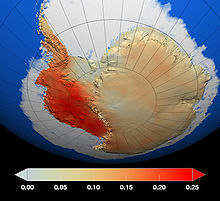Science Behind Sea Level Rise
There are two primary reasons that sea level is rising.
1. Ice is melting and flowing into the world’s oceans.

As temperatures on Earth rise, water is released from polar ice caps and glaciers. After melting, the water makes it way to the oceans and causes sea levels to rise. Recent estimates are that 30% of sea level rise is from glaciers (Science, May 17, 2013). While the change is seasonal and some the of water refreezes during the winter months, the overall trend is more ice melting each year than refreezing.
In the graph you looked at earlier, the lower estimates of how much sea level will rise didn't take into account ice melt.
2. Water in the oceans is expanding.
|
Many substances expand when heated, including water. As temperature increases atoms and molecules move faster, spread out, and occupy more space. The change is small but important. Since the oceans hold vast amounts of water these small changes add up. 
Teacher’s perspective:What other science concepts (especially ones that aren’t easily observable) might students understand better by watching an animation? |
|
Other Factors:
|






